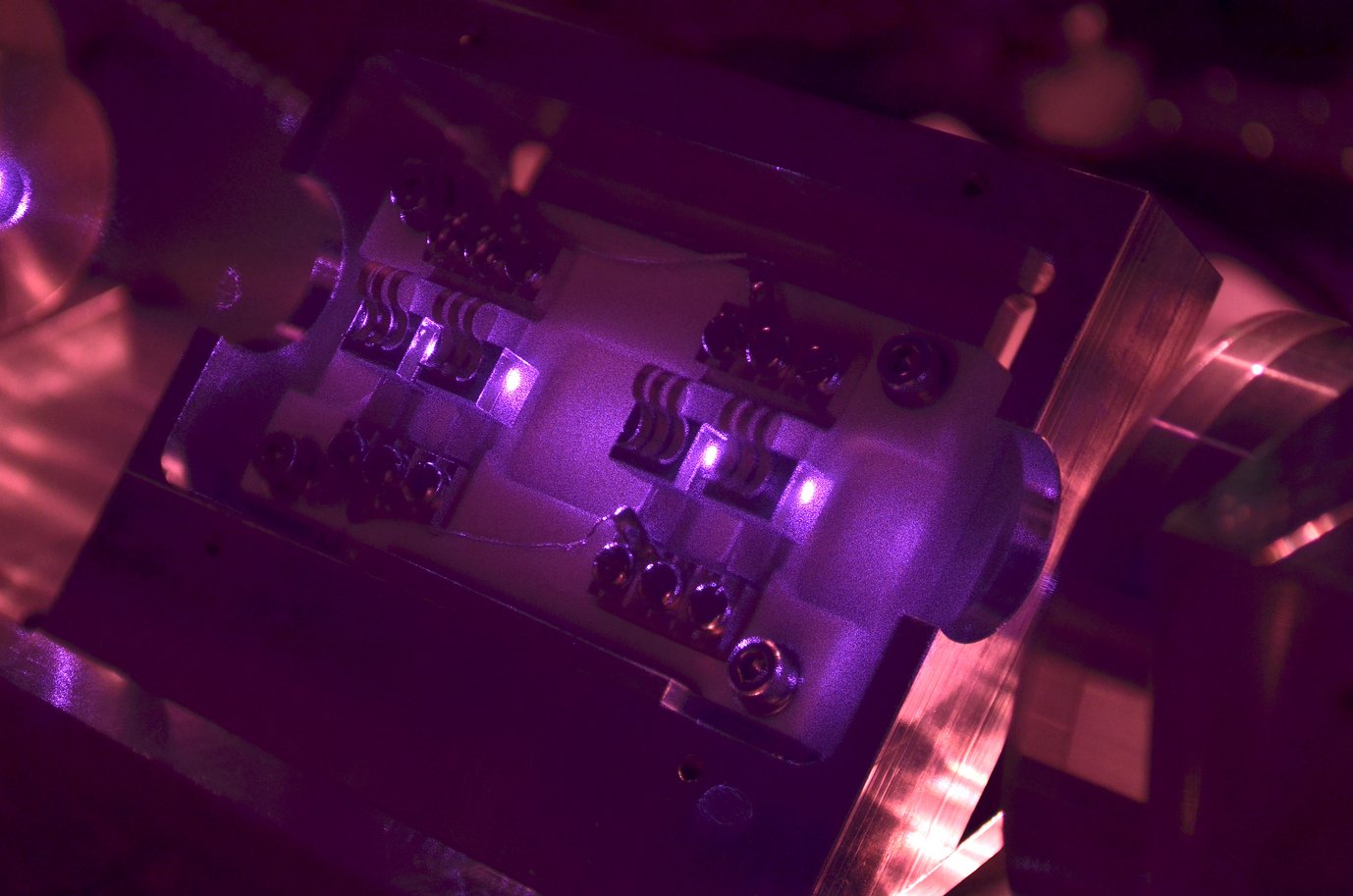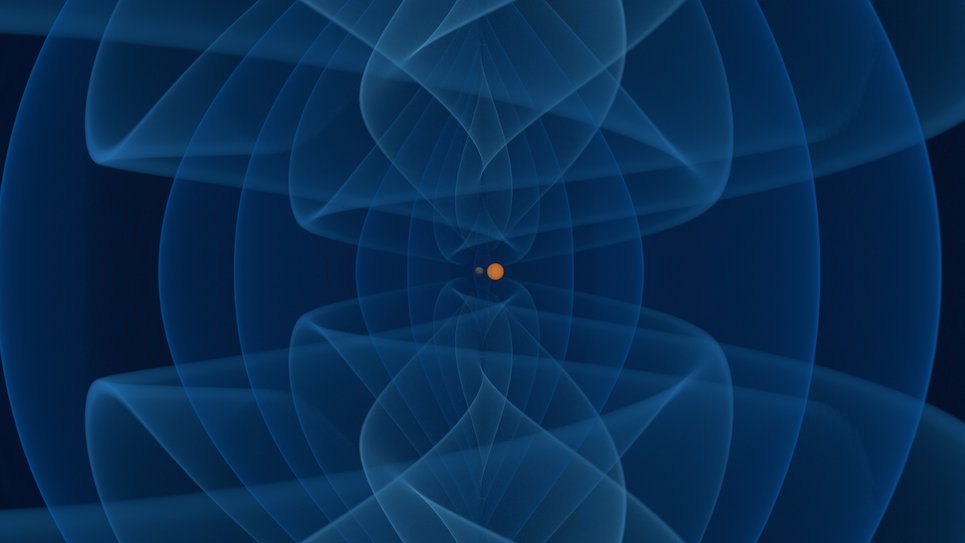Leveling up GEO600
The detector is being upgraded to observe gravitational waves at very high frequencies.

To the point
- Towards entirely new observations: The gravitational-wave detector GEO600 is being upgraded to enable gravitational-wave observations at very high frequencies. The calibration of the detector and first test runs are expected in 2025.
- New insights: The detection of high-frequency gravitational waves could shed light on dark matter, exotic physics, and the early Universe.
- Ready for the future: The upgrades at the cutting edge of science will maintain GEO600's status as a pioneer in gravitational-wave research.
Gravitational waves
Gravitational waves are ripples in space-time that travel at the speed of light. They are caused by the accelerated motion of masses, such as pairs of black holes orbiting each other. The rhythm of this motion determines the rhythm, or frequency, of the gravitational waves sent out into space: The faster the orbital motion, the higher the frequency of the gravitational waves.
Current instruments such as LIGO, Virgo, and KAGRA observe gravitational waves in a frequency window from 10 hertz to 6000 hertz, where hertz measures oscillations per second. In this window, mergers of black holes and / or neutron stars are routinely observed, with more than 90 confirmed signals and more than 200 signal candidates as of today. Signals from rotating isolated neutron stars and stellar explosions are also expected in this frequency range.
Insights into dark matter, exotic physics, and the early Universe
“Our Universe may harbor exotic objects that emit gravitational waves at very high frequencies – up to a million hertz and beyond,” says James Lough, the GEO600 lead scientist. “Searching for, finding and also failing to find these rapidly oscillating space-time ripples will deepen our understanding of cold dark matter, exotic physics, and the early Universe.”
Upgrading a gravitational-wave detector

There are two major upgrades at GEO600. They are related to the laser source used to measure the distance changes caused by gravitational waves, and to making and digitally storing these measurements.
The laser source at GEO600, which served as a “blueprint” for the laser systems used in other gravitational-wave detectors worldwide, has been upgraded. A new laser amplifier has been installed that will provide up to 70 watts of laser power to the detector and increase its measurement precision.
Additionally, the data acquisition system at GEO600 will be upgraded with new components. These will take measurement data 4 million times each second to enable the observation of high-frequency gravitational waves. Previously, GEO600 data were sampled 16 thousand times each second, far too slow for the planned new observations.
The path towards observing very high frequency gravitational waves
The new high-power laser amplifier has been successfully installed at GEO600 in August 2024. It has been running reliably since then. First data have been taken with the new high-speed acquisition system.
“Our next steps will be putting everything together to calibrate the detector, assess its sensitivity, hunt for noise sources and mitigate them to further improve sensitivity,” explains James Lough. “Once everything is in place, it's going to get exciting. Then we can start the first test observations and feed the new data into our data analysis pipeline.”
“This is a step into uncharted territory and a realm of new gravitational-wave sources. GEO600 scientists will look for signals that no one has been able to search for before,” adds Karsten Danzmann.
Background information
Sources of high-frequency gravitational waves
According to our current understanding, our Universe contains five times more dark matter than ordinary matter. The nature of this ubiquitous yet elusive form of matter is still unknown. One popular explanation is that it consists of an unknown elementary particle.
Certain types of the this dark matter, called “ultralight bosons“, could form clouds around black holes. Typical black holes spin rapidly with a lot of energy stored in their rotation. Ultralight bosons particles in these clouds can tap into this energy reservoir and convert it into high-frequency gravitational waves through a process known as “black hole superradiance”.
The gravitational waves generated by boson clouds around spinning black holes would be sent into space for very long times. Their frequency depends on the mass of the (unknown) ultra-light bosons and on the properties of the black hole they orbit. The search for high-frequency gravitational waves with GEO600 will target such clouds in which the bosons have masses in a previously unexplored range.
Other possible sources of high-frequency gravitational waves are
- Mergers of very light black holes formed in the early Universe, called primordial black holes,
- Mergers of exotic compact objects, which resemble neutron stars and black holes, but which are composed of yet unknown elementary particles,
- Various processes in the early Universe.
Tuning the detector: scanning at high frequencies
Gravitational waves change the brightness of the laser beam leaving the interferometer that is at the heart of the detectors. Sending these brightness changes back into the interferometer with a carefully placed partially reflective mirror can increase the overall gravitational-wave sensitivity of the detector.
This method known as “signal recycling” can also be used to “detune” the detector, making it much more sensitive to a specific, rather narrow band of frequencies – similar to tuning an FM radio to a specific station. In gravitational-wave detectors this is done by adjusting the position of the partially reflective mirror by microscopic amounts. The GEO600 team has experience with this: They operated their detector in this detuned mode before to optimize the detector's sensitivity to gravitational waves.
Tuning the detector to gravitational waves of a certain frequency is not a free lunch. This makes the instrument less sensitive to frequencies outside the target frequency band. By repeatedly changing the detuning and observing at the best sensitivity, it is possible to scan a wide range of frequencies with sensitivities that would otherwise be unattainable.
For continuous gravitational waves at very high frequencies, which GEO600 will target, this detuning plays a key role in covering the wide range of possible signal frequencies and types.

